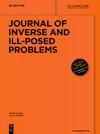Direct numerical algorithm for calculating the heat flux at an inaccessible boundary
IF 0.9
4区 数学
Q2 MATHEMATICS
引用次数: 0
Abstract
Abstract A fast numerical algorithm for solving the Cauchy problem for elliptic equations with variable coefficients in standard calculation domains (rectangles, circles, or rings) is proposed. The algorithm is designed to calculate the heat flux at the inaccessible boundary. It is based on the separation of variables method. This approach employs a finite difference approximation and allows obtaining a solution to a discrete problem in arithmetic operations of the order of计算不可达边界处热流密度的直接数值算法
摘要提出了一种快速求解标准计算域(矩形、圆或环)变系数椭圆方程Cauchy问题的数值算法。该算法用于计算不可达边界处的热流密度。它是基于分离变量法。这种方法采用了有限差分近似,并允许在N¹ln (N N\operatorname{ln}N)阶的算术运算中得到离散问题的解,其中的二进制运算是网格点的个数。一般来说,求解椭圆型方程的柯西问题需要迭代过程。目前可用于解决柯西问题的直接算法仅针对常系数算子(拉普拉斯,亥姆霍兹)和使用具有此类算子的问题的解析解而开发。本文结果的一个新特点是直接算法可用于(特殊形式的)变系数椭圆算子。重要的是,在这种情况下,无法得到问题的解析解。该算法显著增加了可解决问题的范围。它可以用来创建设备,以确定在非均匀结构的部分,不能测量的实时热通量。例如,要确定由不同材料制成的管道的内半径上的热通量。
本文章由计算机程序翻译,如有差异,请以英文原文为准。
求助全文
约1分钟内获得全文
求助全文
来源期刊

Journal of Inverse and Ill-Posed Problems
MATHEMATICS, APPLIED-MATHEMATICS
CiteScore
2.60
自引率
9.10%
发文量
48
审稿时长
>12 weeks
期刊介绍:
This journal aims to present original articles on the theory, numerics and applications of inverse and ill-posed problems. These inverse and ill-posed problems arise in mathematical physics and mathematical analysis, geophysics, acoustics, electrodynamics, tomography, medicine, ecology, financial mathematics etc. Articles on the construction and justification of new numerical algorithms of inverse problem solutions are also published.
Issues of the Journal of Inverse and Ill-Posed Problems contain high quality papers which have an innovative approach and topical interest.
The following topics are covered:
Inverse problems
existence and uniqueness theorems
stability estimates
optimization and identification problems
numerical methods
Ill-posed problems
regularization theory
operator equations
integral geometry
Applications
inverse problems in geophysics, electrodynamics and acoustics
inverse problems in ecology
inverse and ill-posed problems in medicine
mathematical problems of tomography
 求助内容:
求助内容: 应助结果提醒方式:
应助结果提醒方式:


